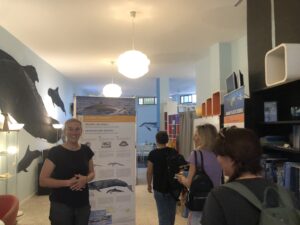
Welcome Home!
by Ricarda Scholz
This course had been at the back of my mind for several years. This was to be the year that I would finally take part in it – it was fate. The request was sent, booked, planned! Let’s go!
I’ve never been to the island of La Gomera, let alone any of the other Canary Islands, so I was really looking forward to all the new impressions. From the course itself, I expected that we as a group would be introduced to behavioural research and gain theoretical as well as practical insights into it. I was also very excited about the exchange regarding the environmental issues that exist locally and worldwide regarding marine pollution, whaling, fishing, etc. and potential or existing solutions to these issues. And of course I couldn’t wait to actually see the whales and dolphins!
My expectations were more than fulfilled. Unfortunately, we weren’t lucky enough to see whales or dolphins on our trips every day, but of course there is always the chance that can happen. Nevertheless, it is always unbelievable to see them in their natural habitat. The nature and atmosphere on the island are just as fascinating, I was enchanted by the island! Being so close to the history of a volcano and seeing the forces of nature so close together was simply overwhelming!
We gained a lot of knowledge during our working meetings and it was explained and demonstrated to us how to effectively observe the animals. During the trips this newly gained knowledge was then put into practice:
How are the animals behaving? Take photos quickly! As many as possible! The boat is rolling! Watch the breathing! The group structure – are they dispersed or close together? How many are there? Are there any young animals or newborns? How do I differentiate between these? What was the term for that? Look, look, look. What are the animals doing? Are there any interactions with the boat?
Implementing what I had previously learned during the observations was a bit of a challenge for me because I was so euphoric, I wanted to savour the moment and had blocked out the surroundings while wanting to simultaneously concentrate on the theory. It was a great feeling to observe the animals with the acquired knowledge. What is actually going on there? How are they doing? What are they doing? Which animals are there and why are they doing this or that?
On all of our trips we also rescued young Cory’s shearwaters from their predicament, as many were unable to continue flying after taking off from the cliffs and were drifting helplessly on the water´s surface. We got them into the boat and brought them to shore, where they were taken to a rescue center to be taken care of. We also collected rubbish on every trip, such as a rope, a chlorine bottle, plastic parts, tires, etc.
The most impressive thing besides the whale and dolphin sightings was being able to listen to their interactions through a hydrophone, even though we couldn’t see them. On a day when we had no sightings, we put the hydrophone in the water and could hear clicking noises and whistles – but there was not one animal in sight. This was was the moment we realised that they are there, even if we couldn’t see them. That was one of the most exciting moments of the course, realising that even if no one opens the door, someone is at home. As if we were standing, uninvited, in front of our neighbour’s closed door, but we can hear him talking. He just doesn’t seem to be interested in us, or doesn’t have the time, he’s just busy doing something else. It’s his right if we show up unannounced. This freedom also belongs to the whales and dolphins. They decide whether they want to open the door for you or whether they want to be left alone, not watched or accompanied. Even though they are at home.
A big thanks to the animals and the great team at M.E.E.R. e.V. and OCEANO for this very special time!




























